Satellite-Based Monitoring on Green-Up Date for Optimizing the Rest-Grazing Period in Xilin Gol Grassland
Abstract
:1. Introduction
2. Materials and Methods
2.1. Study Area
2.2. Data Preparation
- (1)
- Climatic data. The data on temperature, precipitation (spatial resolution = 1 km) and solar radiation (spatial resolution = 10 km) were all from the National Earth System Science Data Center [57]. We acquired both the annual and monthly data of China and then extracted them by the mask of Xilin Gol Grassland in ArcGIS;
- (2)
- NPP. We acquired the 2000~2016 NPP in China from the Earth Databank of Chinese Academy of Sciences [58], with a temporal resolution of 8 days and spatial resolution of 500 m. We calculated the annual average NPP using raster calculator in ArcGIS and also extracted it in Xilin Gol Grassland;
- (3)
- NDVI, EVI and LSWI. EVI considers the blue band on the basis of infrared and near-infrared bands, which further reduces the noises and the saturation phenomenon of NDVI [45,46,47,48,49]. However, for grasslands whose structure is not as complicated as forests, the saturation phenomenon of NDVI can hardly appear, so both NDVI and EVI are effective indicators for reflecting the monitoring the green-up date of grasslands. In this study, we compared the temporal variations of NDVI and EVI to verify the accuracy of such two time series, based on which we monitored the green-up date. The short-wave infrared band is very sensitive to moisture, whose combination with the near-infrared band generates the Land Surface Water Index (LSWI), an effective reflection of the moisture content of vegetation and soil [59,60]. We selected MODIS (MOD09AI) data from 2000 to 2018, with a temporal resolution of 8 days and spatial resolution of 500 m, and calculated the NDVI, EVI and LSWI of each image (46 images per year). The calculation formula is as follows:
- (4)
- Spatial distributions of grasslands. We selected China’s land cover data in 2000, 2005, 2010, 2013, 2015 and 2018 from the Resources and Environmental Sciences Data Center of Chinese Academy of Sciences [61], with a spatial resolution of one kilometer. We first extracted the grasslands in these years respectively and selected those areas that were always grasslands during this period. Then we use the administrative boundaries of Xilin Gol to extract them in ArcGIS, to acquire the spatial distribution of grasslands in Xilin Gol;
- (5)
- Surface observation data of green-up date. During our survey in 2019, we obtained a series of surface observation data of green-up dates in seven sites in different years, based on which we verified the green-up date monitored through remote sensing (Table 1). Meanwhile, we also collected the starting date of rest-grazing in each county according to our surveys and relevant policies.
2.3. Extraction, Verification and Analysis of Green-Up Date
2.3.1. Extraction of Green-Up Date
2.3.2. Verification of Green-Up Date
2.3.3. Analysis on the Spatiotemporal Variations of Green-Up Date
3. Results and Analysis
3.1. Spatiotemporal Variations of Green-Up Date
3.2. Stability of Green-Up Date
3.3. Discrepancies between Green-Up Process and Rest-Grazing Period
4. Discussion
4.1. Monitor the Changes of Green-Up Date and Climate Driving Forces
4.2. Optimize Rest-Grazing Period to Avoid Starting Rest-Grazing Too Early
5. Conclusions
Author Contributions
Funding
Data Availability Statement
Acknowledgments
Conflicts of Interest
References
- Bardgett, R.D.; Bullock, J.M.; Lavorel, S.; Manning, P.; Schaffner, U.; Ostle, N.; Chomel, M.; Durigan, G.; Fry, E.L.; Johnson, D.; et al. Combating global grassland degradation. Nat. Rev. Earth Environ. 2021, 2, 720–735. [Google Scholar] [CrossRef]
- Mishra, N.B.; Crews, K.A.; Neeti, N.; Meyer, T.; Young, K.R. MODIS derived vegetation greenness trends in African Savanna: Deconstructing and localizing the role of changing moisture availability, fire regime and anthropogenic impact. Remote Sens. Environ. 2015, 169, 192–204. [Google Scholar] [CrossRef]
- He, F.Q.; Chen, D.D.; Li, Q.; Huo, L.L.; Zhao, L.; Li, C.L.; Chen, X. Temporal and Spatial Patterns of Herbage and Nutrient Carrying Capacity of Alpine Grassland of Sanjiangyuan. Acta Agrestia Sin. 2021, 29, 2808–2816. [Google Scholar]
- Wang, H.; Zhou, Y.K.; Wang, X.Y.; Zhou, C.H. Spatiotemporal Changes in Vegetation Growth Peak and the Response to Climate and Phenology over Northeast China. Remote Sens. Technol. Appl. 2021, 36, 3977. [Google Scholar] [CrossRef]
- Xu, Z.C.; Song, Y.T.; Wu, Y.N.; Huo, G.W.; Wang, X.M.; Dao, R.N. Effect of grazing intensities on soil enzyme activities and soil microbial biomass of Stipa krylovii steppe in different phenological periods. Chin. J. Ecol. 2016, 35, 2022–2028. [Google Scholar]
- Cai, H.Y.; Yang, X.H.; Xu, X.L. Human-induced grassland degradation/restoration in the central Tibetan Plateau: The effects of ecological protection and restoration projects. Ecol. Eng. 2015, 83, 112–119. [Google Scholar] [CrossRef]
- Zhou, W.; Gang, C.C.; Zhou, L.; Chen, Y.Z.; Li, J.L.; Ju, W.M.; Odeh, I. Dynamic of grassland vegetation degradation and its quantitative assessment in the northwest China. Acta Oecol. 2014, 55, 86–96. [Google Scholar] [CrossRef]
- Qin, J.P.; Liu, Y.; Ma, Y.S.; Wang, Y.L.; Li, S.X. Effects of Rest Grazing on Vegetation Characteristics and Photosynthetic Physiology of Dominant Species in Degraded Alpine Grasslands During Greenup Period. Acta Agrestia Sin. 2021, 29, 1034–1042. [Google Scholar]
- Ma, Y.S.; Li, S.X.; Wang, Y.L.; Sun, X.D.; Jing, M.L.; Li, S.Y.; Li, L.Q.; Wang, X.L. Effect of Rest-grazing in the Greenup Period on Degraded Vegetation in Alpine Meadow. Acta Agrestia Sin. 2017, 25, 290–295. [Google Scholar]
- Gao, X.Y.; Lu, X.Y. Effects of rest grazing on vegetation and soil characteristics of alpine steppe and alpine meadow in Tibet. Pratacult. Sci. 2020, 37, 486–496. [Google Scholar]
- Li, L.Q.; Ma, Y.S.; Li, S.X.; Wang, X.L.; Wang, Y.L.; Jing, M.L.; Li, S.Y.; Nian, Y.; Han, H.L. Effects of rest-grazing in the regreen-up period on moderately degraded steppification meadow of Qilian Mountain. Pratacult. Sci. 2017, 34, 2016–2022. [Google Scholar]
- Wang, T.W.; Zhang, Z.; Li, Z.B.; Li, P. Grazing management affects plant diversity and soil properties in a temperate steppe in northern China. CATENA 2017, 158, 141–147. [Google Scholar] [CrossRef]
- Liu, Y.; Chang, X.F.; Tian, F.P.; Liu, Z.H.; Dang, Z.Q.; Wu, G.L. Effects of Grazing on Community and Soil Characteristics in the Semi-arid Grassland. Acta Bot. Boreali-Occident. Sin. 2016, 36, 2524–2532. [Google Scholar]
- Gu, W.R.; Zhang, X.H.; Zhu, J.Z.; Sun, Z.J.; Mu, X.Y.; Wang, X.J. Impact of Seasonal Rest Grazing on Plant Community Quantity Characteristics under Different Grazing Intensities. Xinjiang Agric. Sci. 2013, 50, 1145–1149. [Google Scholar]
- Zhou, J.Q.; Tian, Y.; Wu, Y.Q.; Liu, J.K.; Zhang, K.B. Characteristics of Grassland Vegetation Community under Different Grazing Management and Its Relationship with Soil Factors: A Case Study of Xin Barag Zuoqi. Ecol. Environ. Sci. 2019, 28, 1117–1126. [Google Scholar]
- Wang, X.L.; Wen, J.; Ma, Y.S.; Wang, Y.L.; Shi, J.J.; Zhou, H.K. Utilization of Different Carbon Source Types in Biology-GN Microplates by Soil Microbial Community from Different Rest-grazing Periods in Green-up Spring. Ecol. Environ. Sci. 2020, 29, 961–970. [Google Scholar]
- Li, Y.J.; Song, X.L.; Xiu, W.M.; Zhang, G.L.; Liu, H.M.; Zhao, J.N.; Yang, D.L. Effects of Spring Rest Grazing on Organic Carbon Storage in Leymus Chinensis Steppe in Inner Mongolia, China. J. Agro-Environ. Sci. 2013, 32, 2221–2230. [Google Scholar]
- Lang, M.; Li, P.; Long, G.Q.; Yuan, F.J.; Yu, Y.J.; Ma, E.D.; Shan, J.; Muller, C.; Zhu, T.B. Grazing rest versus no grazing stimulates soil inorganic N turnover in the alpine grasslands of the Qinghai-Tibet plateau. CATENA 2021, 204, 105382. [Google Scholar] [CrossRef]
- Zhang, Y.J.; Huang, D.; Badgery, W.B.; Kemp, D.R.; Chen, W.Q.; Wang, X.Y.; Liu, N. Reduced grazing pressure delivers production and environmental benefits for the typical steppe of north China. Sci. Rep. 2015, 5, 16434. [Google Scholar] [CrossRef] [Green Version]
- Zimmer, H.C.; Turner, V.B.; Mavromihalis, J.; Dorrough, J.; Moxham, C. Forb responses to grazing and rest management in a critically endangered Australian native grassland ecosystem. Rangel. J. 2010, 32, 187–195. [Google Scholar] [CrossRef]
- Golding, J.D.; Dreitz, V.J. Songbird response to rest-rotation and season-long cattle grazing in a grassland sagebrush ecosystem. J. Environ. Manag. 2017, 204, 605–612. [Google Scholar] [CrossRef]
- Vold, S.T.; Berkeley, L.I.; McNew, L.B. Effects of Livestock Grazing Management on Grassland Birds in a Northern Mixed-Grass Prairie Ecosystem. Rangel. Ecol. Manag. 2019, 72, 933–945. [Google Scholar] [CrossRef]
- Thomas, B.W.; Gao, X.L.; Zhao, M.L.; Bork, E.W.; Hao, X.Y. Grazing altered carbon exchange in a dry mixed-grass prairie as a function of soil texture. Can. J. Soil Sci. 2018, 98, 136–147. [Google Scholar]
- Chen, X.Q.; Li, J.; Xu, L.; Liu, L.; Ding, D. Modeling greenup date of dominant grass species in the Inner Mongolian Grassland using air temperature and precipitation data. Int. J. Biometeorol. 2014, 58, 463–471. [Google Scholar] [CrossRef]
- Wang, L.H.; Tian, F.; Wang, Y.H.; Wu, Z.D.; Schurgers, G.; Fensholt, R. Acceleration of global vegetation greenup from combined effects of climate change and human land management. Glob. Chang. Biol. 2018, 24, 5484–5499. [Google Scholar] [CrossRef]
- Yu, Z.; Sun, P.; Liu, S.; Wang, J.; Everman, A. Sensitivity of large-scale vegetation greenup and dormancy dates to climate change in the north-south transect of eastern China. Int. J. Remote Sens. 2013, 34, 7312–7328. [Google Scholar] [CrossRef]
- Zhang, X.Y.; Goldberg, M.; Tarpley, D.; Friedl, M.A.; Morisette, J.; Kogan, F.; Yu, Y.Y. Drought-induced vegetation stress in southwestern North America. Environ. Res. Lett. 2010, 5, 024008. [Google Scholar] [CrossRef]
- Jia, Y.S.; Li, Q.F. The Research on the Forage Supplying Module on the Grassland during the Delaying and Resting Grazing Periods. Chin. J. Grassl. 2006, 28, 60–65. [Google Scholar]
- Leisher, C.; Brouwer, R.; Boucher, T.M.; Vogelij, R.; Bainbridge, W.R.; Sanjayan, M. Striking a Balance: Socioeconomic Development and Conservation in Grassland through Community-Based Zoning. PLoS ONE 2011, 6, e28807. [Google Scholar] [CrossRef]
- Briske, D.D.; Zhao, M.; Han, G.; Xiu, C.; Kemp, D.R.; Willms, W.; Havstad, K.; Kang, L.; Wang, Z.; Wu, J.; et al. Strategies to alleviate poverty and grassland degradation in Inner Mongolia: Intensification vs production efficiency of livestock systems. J. Environ. Manag. 2015, 152, 177–182. [Google Scholar] [CrossRef]
- Ahrends, H.E.; Etzold, S.; Kutsch, W.L.; Stöckli, R.; Brügger, R.; Jeanneret, F.; Wanner, H.; Buchmann, N.; Eugster, W. Tree phenology and carbon dioxide fluxes: Use of digital photography for process-based interpretation at the ecosystem scale. Clim. Res. 2009, 39, 261–274. [Google Scholar] [CrossRef] [Green Version]
- Guo, J.; Chen, S.; Xu, B.; Shen, G.; Jin, Y.X.; Zhang, Y.J.; Yang, X.C. Remote sensing monitoring of grassland vegetation greenup based on SPOT-VGT in Xilingol League. Geogr. Res. 2017, 36, 37–48. [Google Scholar]
- Song, C.Q.; You, S.C.; Ke, L.H.; Liu, G.H.; Zhong, X.K. Spatio-temporal variation of vegetation phenology in the Northern Tibetan Plateau as detected by MODIS remote sensing. Acta Phytoecol. Sin. 2011, 35, 853–863. [Google Scholar]
- An, S.; Zhang, X.Y.; Chen, X.Q.; Yan, D.; Henebry, G.M. An Exploration of Terrain Effects on Land Surface Phenology across the Qinghai-Tibet Plateau Using Landsat ETM plus and OLI Data. Remote Sens. 2018, 10, 1069. [Google Scholar] [CrossRef] [Green Version]
- Xu, X.Y.; Riley, W.J.; Koven, C.D.; Jia, G.S. Observed and Simulated Sensitivities of Spring Greenup to Preseason Climate in Northern Temperate and Boreal Regions. J. Geophys. Res.-Biogeosci. 2018, 123, 60–78. [Google Scholar] [CrossRef] [Green Version]
- Deng, G.R.; Zhang, H.Y.; Yang, L.B.; Zhao, J.J.; Guo, X.Y.; Hong, Y.; Wu, R.H.; Dan, G. Estimating Frost during Growing Season and Its Impact on the Velocity of Vegetation Greenup and Withering in Northeast China. Remote Sens. 2020, 12, 1355. [Google Scholar] [CrossRef]
- Zhang, X.Y.; Jayavelu, S.; Liu, L.L.; Friedl, M.A.; Henebry, G.M.; Liu, Y.; Schaaf, C.B.; Richardson, A.D.; Gray, J. Evaluation of land surface phenology from VIIRS data using time series of PhenoCam imagery. Agric. For. Meteorol. 2018, 256, 137–149. [Google Scholar] [CrossRef]
- Justice, C.O.; Townshend, J.R.G.; Holben, B.N.; Tucker, C.J. Analysis of the phenology of global vegetation using meteorological satellite data. Int. J. Remote Sens. 1985, 6, 1271–1318. [Google Scholar] [CrossRef]
- Reed, B.C.; Brown, J.F.; Van der Zee, D.; Loveland, T.R.; Merchant, J.W.; Ohlen, D.O. Measuring phenological variability from satellite imagery. J. Veg. Sci. 1994, 5, 703–714. [Google Scholar] [CrossRef]
- Zhang, X.Y.; Friedl, M.A.; Schaaf, C.B.; Strahler, A.H.; Hodges, J.C.F.; Gao, F.; Reed, B.C.; Huete, A. Monitoring vegetation phenology using MODIS. Remote Sens. Environ. 2003, 84, 471–475. [Google Scholar] [CrossRef]
- Dall’Olmo, G.; Karnieli, A. Monitoring phenological cycles of desert ecosystems using NDVI and LST data derived from NOAA-AVHRR imagery. Int. J. Remote Sens. 2002, 23, 4055–4071. [Google Scholar] [CrossRef]
- Jönsson, P.; Eklundh, L. TIMESAT-a program for analyzing time-series of satellite sensor data. Comput. Geosci. 2004, 30, 833–845. [Google Scholar] [CrossRef] [Green Version]
- Sakamoto, T.; Yokozawa, M.; Toritani, H.; Shibayama, M.; Ishitsuka, N.; Ohno, H. A crop phenology detection method using time-series MODIS data. Remote Sens. Environ. 2005, 96, 366–374. [Google Scholar] [CrossRef]
- Xia, C.F.; Li, J.; Liu, Q.H. Review of advances in vegetation phenology monitoring by remote sensing. J. Remote Sens. 2013, 17, 1–16. [Google Scholar]
- Song, C.Q.; You, S.C.; Ke, L.H.; Liu, G.H.; Zhong, X.K. Phenological variation of typical vegetation types in northern Tibet and its response to climate changes. Acta Ecol. Sin. 2012, 32, 1045–1055. [Google Scholar] [CrossRef] [Green Version]
- Zhou, Y.K. Greenness Index from Phenocams Performs Well in Linking Climatic Factors and Monitoring Grass Phenology in a Temperate Prairie Ecosystem. J. Resour. Ecol. 2019, 10, 481–493. [Google Scholar]
- Xu, D.D.; An, D.S.; Guo, X.L. The Impact of Non-Photosynthetic Vegetation on LAI Estimation by NDVI in Mixed Grassland. Remote Sens. 2020, 12, 1979. [Google Scholar] [CrossRef]
- Jiang, Z.Y.; Huete, A.R. Linearization of NDVI Based on its Relationship with Vegetation Fraction. Photogramm. Eng. Remote Sens. 2010, 76, 965–975. [Google Scholar] [CrossRef]
- Tian, F.; Brandt, M.; Liu, Y.Y.; Verger, A.; Tagesson, T.; Diouf, A.A.; Rasmussen, K.; Mbow, C.; Wang, Y.J.; Fensholt, R. Remote sensing of vegetation dynamics in drylands: Evaluating vegetation optical depth (VOD) using AVHRR NDVI and in situ green biomass data over West African Sahel. Remote Sens. Environ. 2016, 177, 165–176. [Google Scholar] [CrossRef] [Green Version]
- Zhang, T.R.; Chai, X.M.; Li, Z.Z. Characteristics of Vegetation Coverage in Northern China and Its Relationship with Sandstorm. Plateau Meteorol. 2010, 29, 137–145. [Google Scholar]
- Zhang, Q.Y.; Zhang, Y.; Li, L. Preliminary Study on Sand—Dust Storm in the Northern China and Its Prevention and Control. Urban Environ. Urban Ecol. 2002, 15, 48–50. [Google Scholar]
- Su, Q.H.; Sun, L.; Yang, Y.K.; Zhou, X.Y.; Li, R.B.; Jia, S.F. Dynamic Monitoring of the Strong Sandstorm Migration in Northern and Northwestern China via Satellite Data. Aerosol Air Qual. Res. 2017, 17, 3244–3252. [Google Scholar] [CrossRef] [Green Version]
- Miao, L.J.; Jiang, C.; Xue, B.L.; Liu, Q.; He, B.; Nath, R.; Cui, X.F. Vegetation dynamics and factor analysis in arid and semi-arid Inner Mongolia. Environ. Earth Sci. 2015, 73, 2343–2352. [Google Scholar] [CrossRef]
- Yang, Q.; Wang, T.T.; Chen, H.; Wang, Y.D. Characteristics of vegetation cover change in Xilin Gol League based on MODIS EVI data. Trans. Chin. Soc. Agric. Eng. 2015, 31, 191–198. [Google Scholar]
- Wu, X.; Xu, K.; Zhang, J.Y.; Li, J.F. Sand Source of Grassland Desertification and Its Geological Origin in Xilin Gol Steppe of China. J. Desert Res. 2018, 38, 92–100. [Google Scholar]
- Zhuo, L.; Cao, X.; Chen, Z.X.; Shi, P.J. Assessment of Grassland Ecological Restoration Project in Xilin Gol Grassland. Acta Geogr. Sin. 2007, 62, 471–480. [Google Scholar]
- National Earth System Science Data Center. Available online: http://www.geodata.cn/ (accessed on 8 June 2022).
- Earth Databank of Chinese Academy of Sciences. Available online: https://data.casearth.cn/ (accessed on 6 June 2022).
- Ceccato, P.; Gobron, N.; Flasse, S.; Pinty, B.; Tarantola, S. Designing a spectral index to estimate vegetation water content from remote sensing data: Part 1—Theoretical approach. Remote Sens. Environ. 2002, 82, 188–197. [Google Scholar] [CrossRef]
- Ceccato, P.; Flasse, S.; Gregoire, J.M. Designing a spectral index to estimate vegetation water content from remote sensing data—Part 2. Validation and applications. Remote Sens. Environ. 2002, 82, 198–207. [Google Scholar] [CrossRef]
- Resources and Environmental Sciences Data Center of Chinese Academy of Sciences. Available online: http://www.resdc.cn (accessed on 9 June 2022).
- Zhou, J.; Jia, L.; Menenti, M.; Liu, X. Optimal Estimate of Global Biome-Specific Parameter Settings to Reconstruct NDVI Time Series with the Harmonic Analysis of Time Series (HANTS) Method. Remote Sens. 2021, 13, 4251. [Google Scholar] [CrossRef]
- Jiang, X.G.; Wang, D.; Tang, L.L.; Hu, J.; Xi, X.H. Analysing the vegetation cover variation of China from AVHRR-NDVI data. Int. J. Remote Sens. 2008, 29, 5301–5311. [Google Scholar] [CrossRef]
- Xiao, X.M.; Boles, S.; Liu, J.Y.; Zhuang, D.F.; Frolking, S.; Li, C.S.; Salas, W.; Moore, B. Mapping paddy rice agriculture in southern China using multi-temporal MODIS images. Remote Sens. Environ. 2005, 95, 480–492. [Google Scholar] [CrossRef]
- Xiao, X.; Hagen, S.; Zhang, Q.; Keller, M.; Moore, B., III. Detecting leaf phenology of seasonally moist tropical forests in South America with multi-temporal MODIS images. Remote Sens. Environ. 2006, 103, 465–473. [Google Scholar] [CrossRef]
- Liu, A.J.; Han, J.G. Remote sensing for monitoring the key phonological stages of rangeland—A case study in Xilingol. Pratacult. Sci. 2007, 24, 1–5. [Google Scholar]
- Dai, H.Y.; Du, W.L.; Wang, X.J.; Li, D.; Su, D.Y. Climate Type and Net Primary Productivity Evolution Process in Inner Mongolia During 1981~2010. Res. Soil Water Conserv. 2018, 25, 222–226. [Google Scholar]
- Zhao, X.H.; Zhang, F.M.; Han, D.C.; Weng, S.H. Evapotranspiration changes and its attribution in semi-arid regions of Inner Mongolia. Arid Zone Res. 2021, 38, 1614–1623. [Google Scholar]
- Dong, L.L.; Li, Q.Q.; Ding, Y.H. Spatial and temporal characteristics of air temperature over China in spring under the background of global warming. Meteorol. Mon. 2015, 41, 1177–1189. [Google Scholar]
- Wang, H.J.; Zhang, B.; Zhao, C.Y.; Jin, X.H.; Wang, X.M.; Dai, S.P.; Wang, Y.M.; Kang, S.Y.; Liu, Y.Y.; Li, D. The Spatio-temporal Characteristics of Temperature Change in Recent 57 Years in Northern China. Prog. Geogr. 2009, 28, 643–650. [Google Scholar]
- Lin, C.C.; Wang, K.; Sun, Y.M. Study on the change of temperature time series in medium section of agro-pastoral ecotone of northern China during the last 60 years. Acta Agrestia Sin. 2016, 24, 747–753. [Google Scholar]
- Jiao, W.H.; Zhang, B.; Ma, B.; Cui, Y.Q.; Huang, H.; Wang, X.D. Temporal and spatial changes of extreme temperature and its influencing factors in northern China in recent 58 years. Arid Land Geogr. 2020, 43, 1220–1230. [Google Scholar]
- Qiu, B.; Li, W.; Wang, X.; Shang, L.; Song, C.; Guo, W.; Zhang, Y. Satellite-observed solar-induced chlorophyll fluorescence reveals higher sensitivity of alpine ecosystems to snow cover on the Tibetan Plateau. Agric. For. Methodol. 2019, 271, 126–134. [Google Scholar] [CrossRef]
- Ren, Y.; Yang, K.; Wang, H.; Zhao, L.; Chen, Y.; Zhou, X.; La, Z. The South Asia Monsoon Break Promotes Grass Growth on the Tibetan Plateau. J. Geogr. Res. Biogeosci. 2022, 126, e2020JG005951. [Google Scholar] [CrossRef]
- Jones, M.O.; Kimball, J.S.; Nemani, R.R. Asynchronous Amazon forest canopy phenology indicates adaptation to both water and light availability. Environ. Res. Lett. 2014, 9, 124021. [Google Scholar] [CrossRef]
- Zhang, W.; Bao, G.; Bao, Y.H. Vegetation SOS dynamic monitoring in Inner Mongolia from 1982 to 2013 and Its responses to climatic changes. China Agric. Inform. 2018, 30, 63–75. [Google Scholar]
- Li, X.H.; Chen, S.H.; Han, F. Vegetation SOS dynamic monitoring in Inner Mongolia from 1982 to 2013 and Its responses to climatic changes. Pratacultural Sci. 2013, 30, 452–456. [Google Scholar]
- Yan, M.; Zuo, H.J.; Zhang, Y.; Chang, H. Reviving characteristic of Stipa grandis and its relationship with meteorological factors in xilinhot steppe. Ecol. Environ. Sci. 2019, 28, 1307–1312. [Google Scholar]
- Liu, Y.Y.; Ren, H.Y.; Zhang, Z.Y.; Zhang, W.; Zhang, Z.X.; Basang, C.; Wang, Y.B.; Wen, Z.M. Temporal and Spatial Dynamic Pattern of Grassland Coverage and Its Influencing Factors in China. Res. Soil Water Conserv. 2022, 29, 221–230. [Google Scholar]
- Chen, K. Analysis on the Change of Vegetation Coverage and Its Influencing Factors in Xilingol League; Inner Mongolia University: Hohhot, China, 2021. [Google Scholar]
- Wang, Z. Discussion on the regulatory legislation of banning grazing and delay grazing. Pratacult. Sci. 2016, 33, 1440–1446. [Google Scholar]
- Fan, S.-Y.; Xu, Y.-C.; Duan, S.-Q.; Lan, J.; Xu, J. Measurement of transaction cost of rest-grazing policy. Chin. J. Eco-Agric. 2012, 20, 1248–1253. [Google Scholar] [CrossRef]
- Luo, Q.; Zhen, L.; Yang, W.N.; Xu, Z.R. The influence of ecological restoration projects on cultural ecosystem services in the Xilin Gol Grassland. J. Nat. Resour. 2020, 35, 119–129. [Google Scholar]
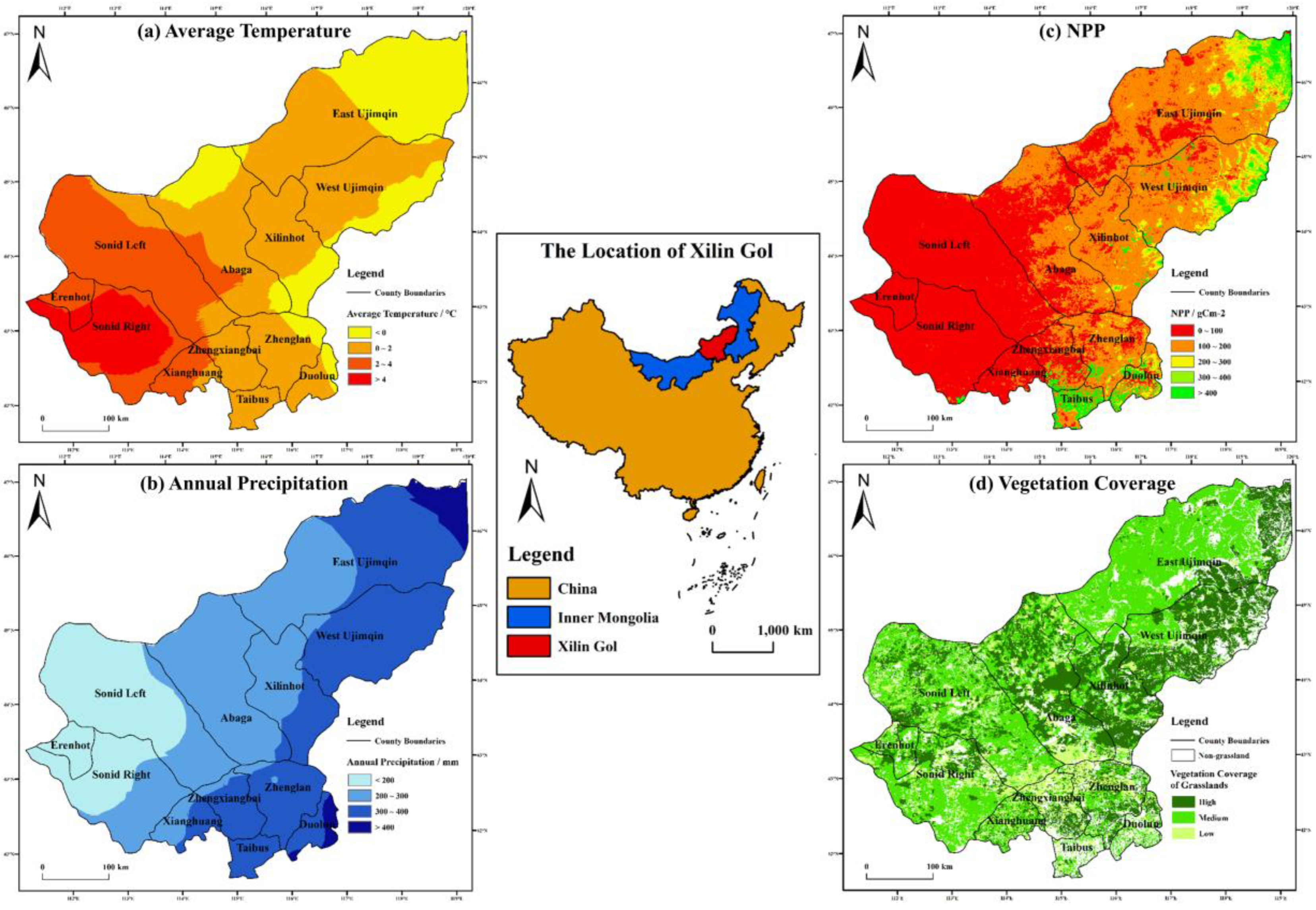
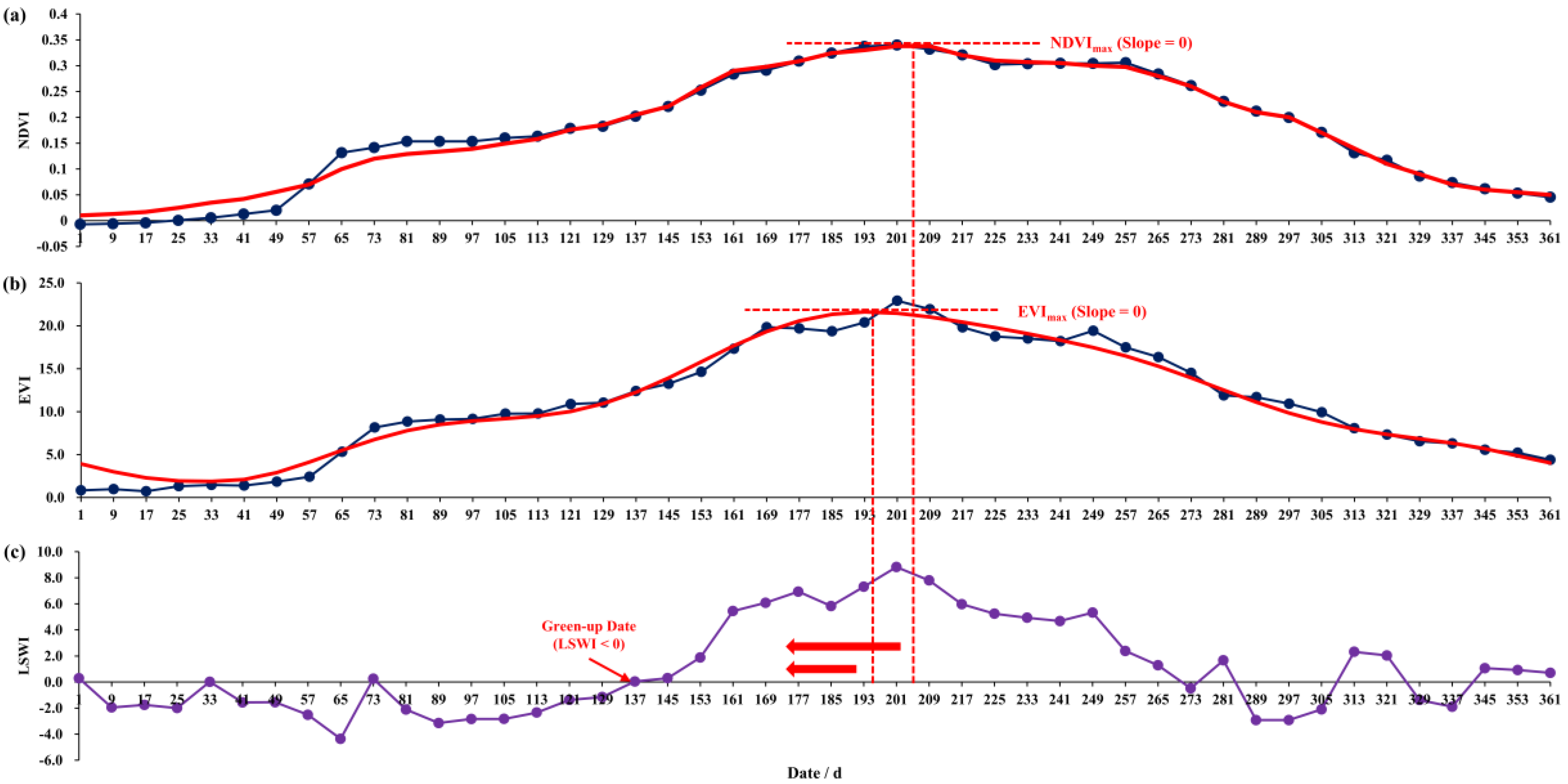
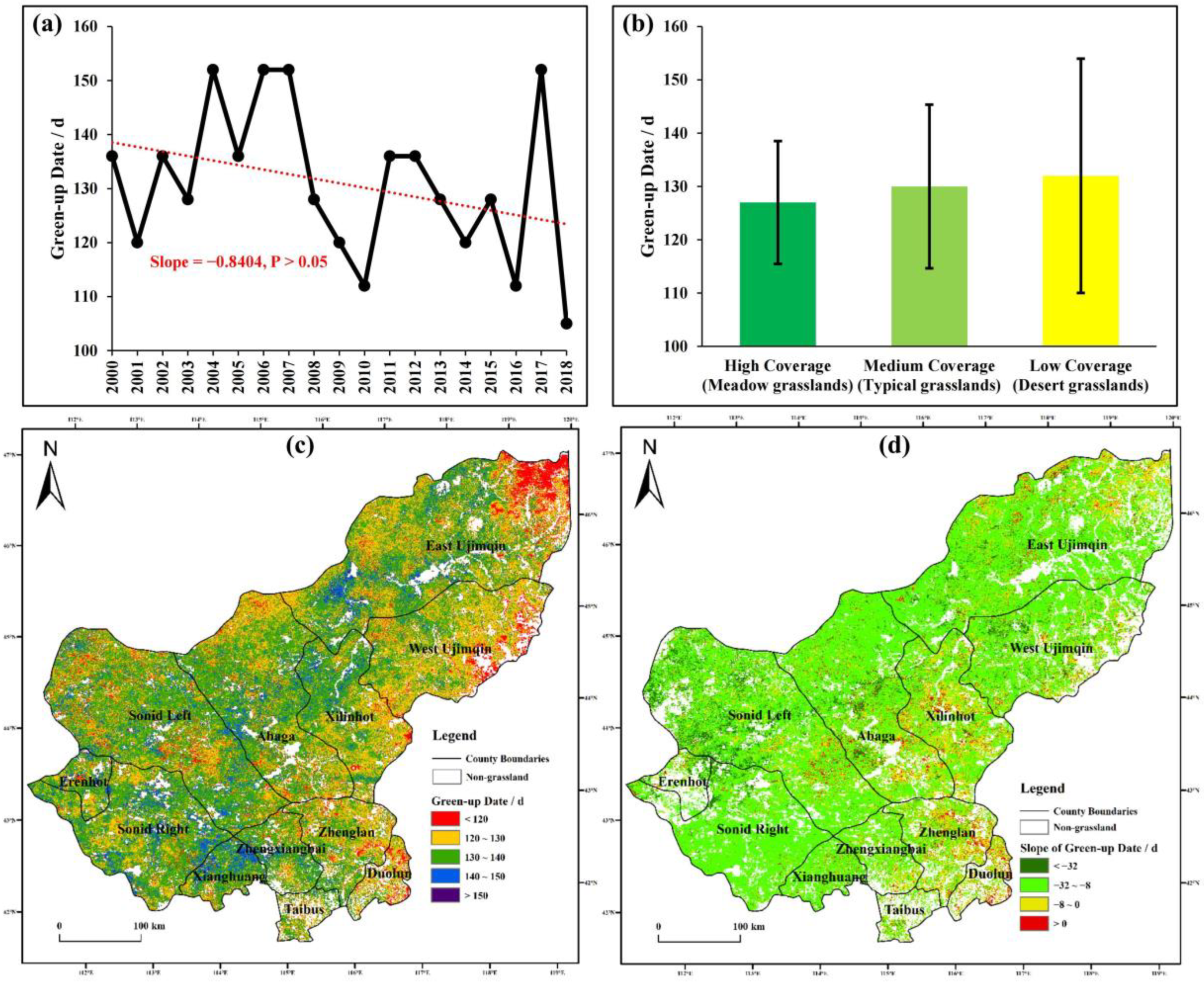
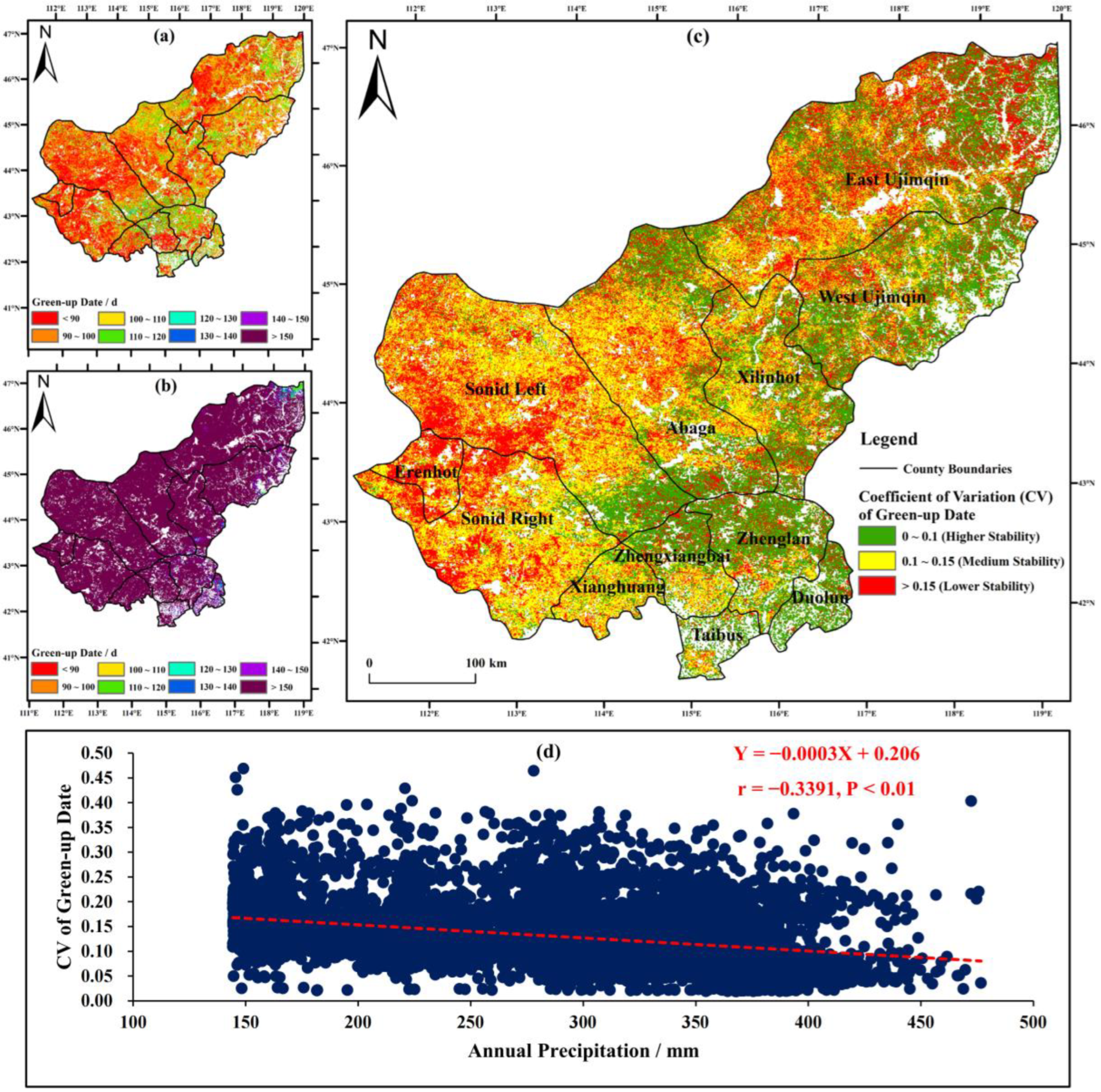
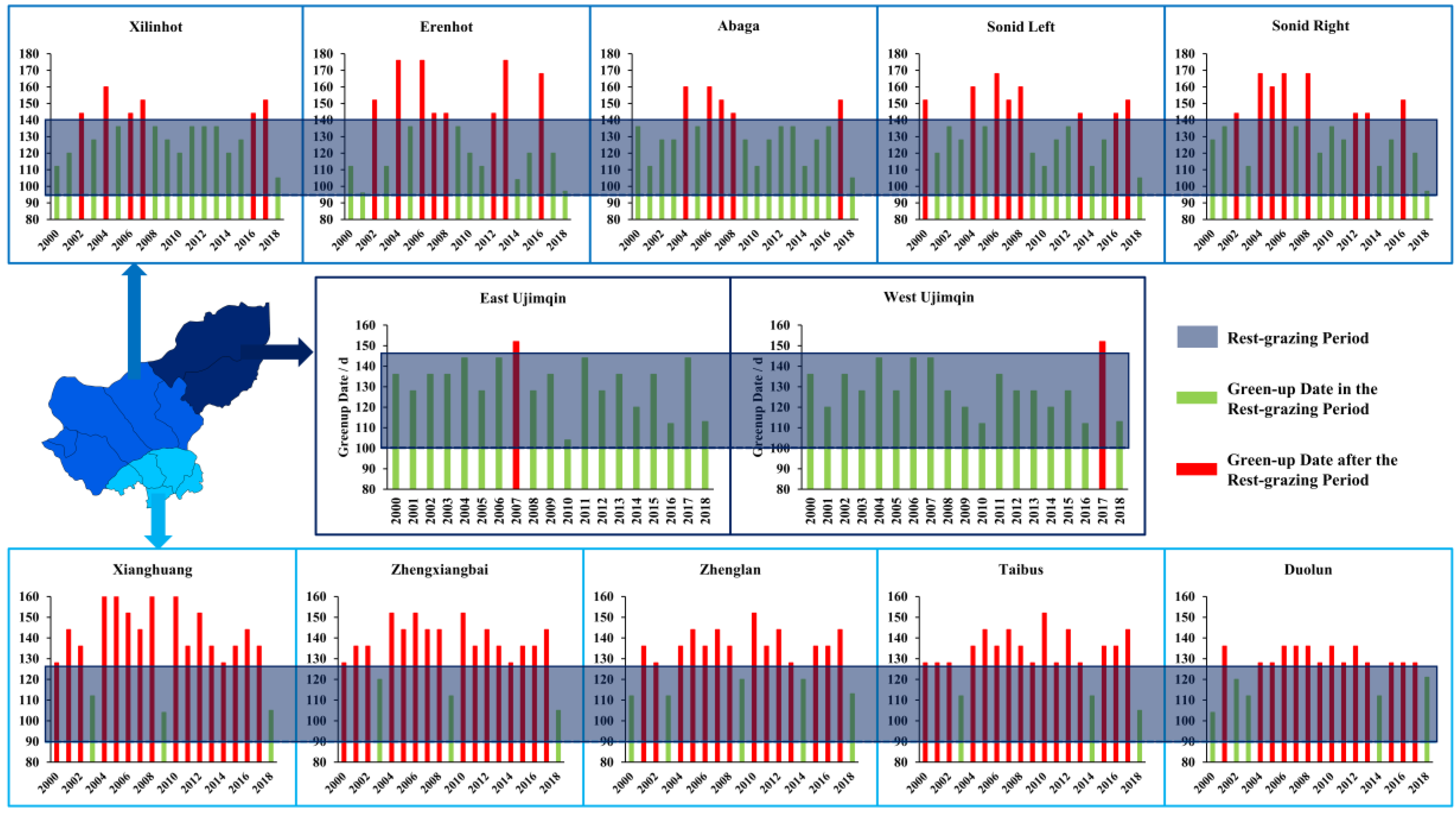
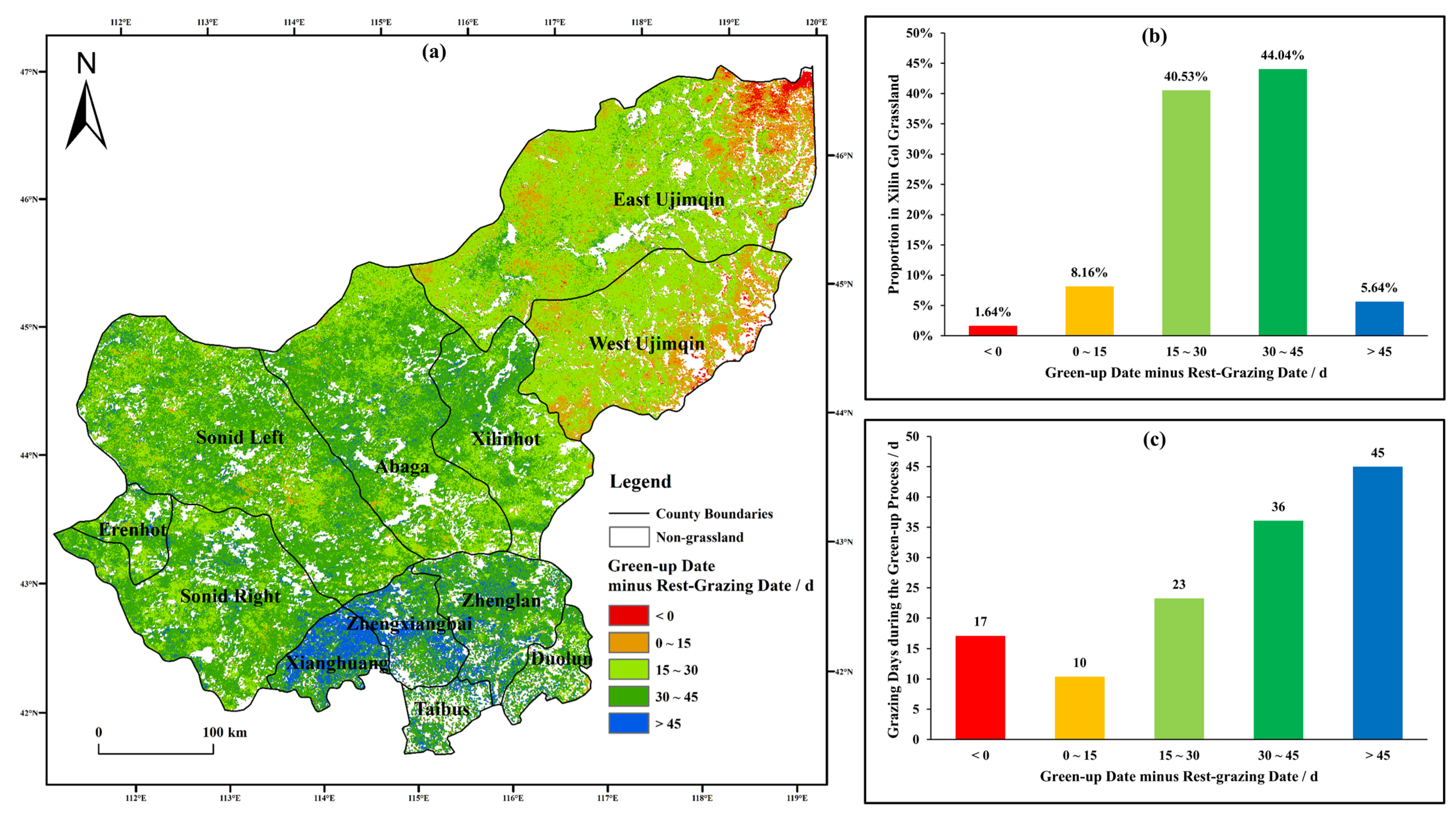
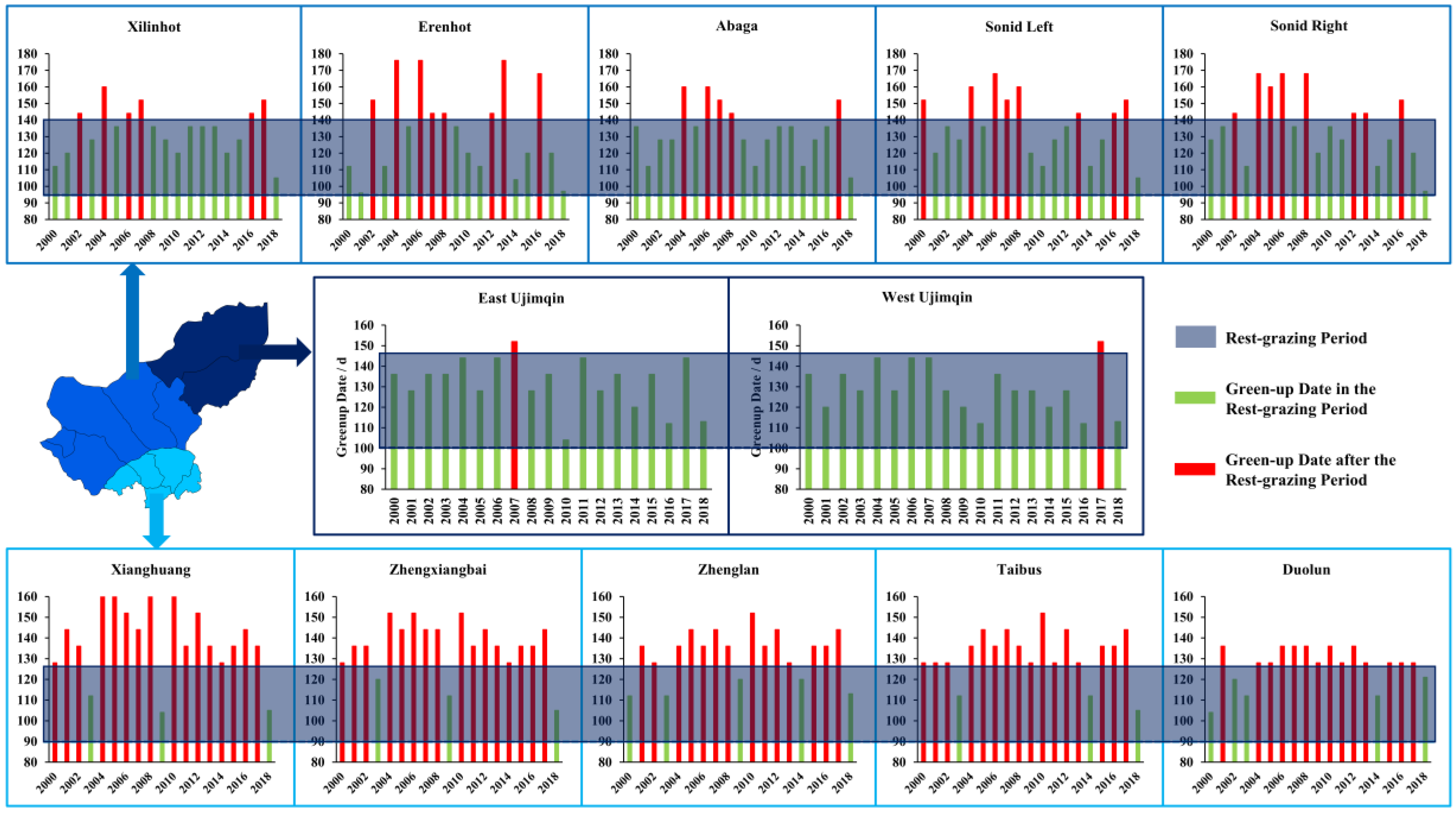
| Surface Observation Sites | Longitudes | Latitudes | Years |
|---|---|---|---|
| Xilinhot | 116°12′ | 43°57′ | 2015, 2016, 2017, 2018 |
| East Ujimqin | 116°58′ | 45°27′ | 2016, 2017 |
| West Ujimqin | 117°56′ | 44°40′ | 2016, 2017 |
| Zhenglan | 115°51′ | 42°33′ | 2003, 2004, 2005, 2006, 2007, 2008, 2016, 2017 |
| Abaga | 114°49′ | 44°15′ | 2016, 2017 |
| Sonid Right | 112°42′ | 42°47′ | 2016, 2017 |
| Taibus | 115°20′ | 41°52′ | 2016, 2017 |
Publisher’s Note: MDPI stays neutral with regard to jurisdictional claims in published maps and institutional affiliations. |
© 2022 by the authors. Licensee MDPI, Basel, Switzerland. This article is an open access article distributed under the terms and conditions of the Creative Commons Attribution (CC BY) license (https://creativecommons.org/licenses/by/4.0/).
Share and Cite
Wang, B.; Yan, H.; Wen, X.; Niu, Z. Satellite-Based Monitoring on Green-Up Date for Optimizing the Rest-Grazing Period in Xilin Gol Grassland. Remote Sens. 2022, 14, 3443. https://doi.org/10.3390/rs14143443
Wang B, Yan H, Wen X, Niu Z. Satellite-Based Monitoring on Green-Up Date for Optimizing the Rest-Grazing Period in Xilin Gol Grassland. Remote Sensing. 2022; 14(14):3443. https://doi.org/10.3390/rs14143443
Chicago/Turabian StyleWang, Boyu, Huimin Yan, Xin Wen, and Zhongen Niu. 2022. "Satellite-Based Monitoring on Green-Up Date for Optimizing the Rest-Grazing Period in Xilin Gol Grassland" Remote Sensing 14, no. 14: 3443. https://doi.org/10.3390/rs14143443
APA StyleWang, B., Yan, H., Wen, X., & Niu, Z. (2022). Satellite-Based Monitoring on Green-Up Date for Optimizing the Rest-Grazing Period in Xilin Gol Grassland. Remote Sensing, 14(14), 3443. https://doi.org/10.3390/rs14143443






